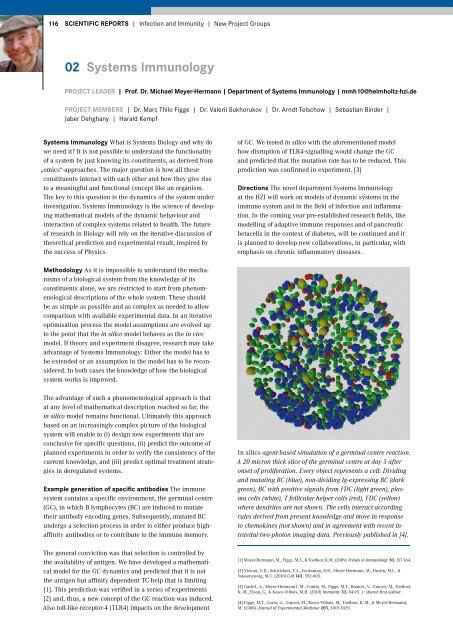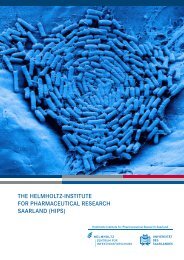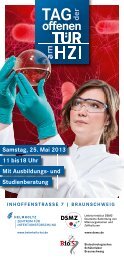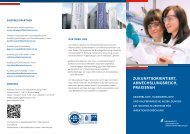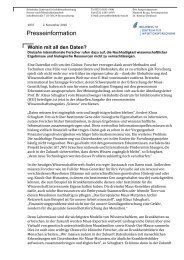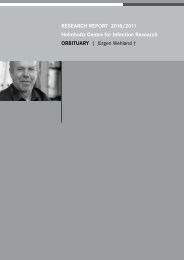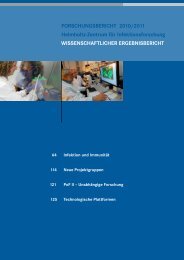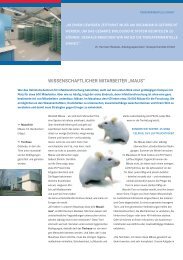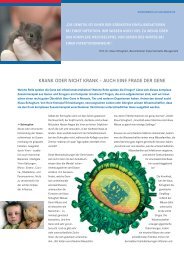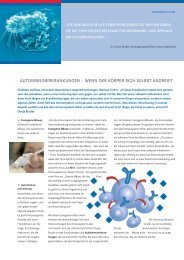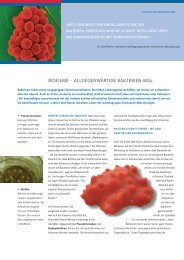Research Report 2010 2011 - Helmholtz-Zentrum für ...
Research Report 2010 2011 - Helmholtz-Zentrum für ...
Research Report 2010 2011 - Helmholtz-Zentrum für ...
Create successful ePaper yourself
Turn your PDF publications into a flip-book with our unique Google optimized e-Paper software.
116 SCIENTIFIC REPORTS | Infection and Immunity | New Project Groups<br />
02 Systems Immunology<br />
PROJECT LEADER | Prof. Dr. Michael Meyer-Hermann | Department of Systems Immunology | mmh10@helmholtz-hzi.de<br />
PROJECT MEMBERS | Dr. Marc Thilo Figge | Dr. Valerii Sukhorukov | Dr. Arndt Telschow | Sebastian Binder |<br />
Jaber Dehghany | Harald Kempf<br />
Systems Immunology What is Systems Biology and why do<br />
we need it? It is not possible to understand the functionality<br />
of a system by just knowing its constituents, as derived from<br />
„omics“-approaches. The major question is how all these<br />
constituents interact with each other and how they give rise<br />
to a meaningful and functional concept like an organism.<br />
The key to this question is the dynamics of the system under<br />
investigation. Systems Immunology is the science of developing<br />
mathematical models of the dynamic behaviour and<br />
interaction of complex systems related to health. The future<br />
of research in Biology will rely on the iterative discussion of<br />
theoretical prediction and experimental result, inspired by<br />
the success of Physics.<br />
of GC. We tested in silico with the aforementioned model<br />
how disruption of TLR4-signalling would change the GC<br />
and predicted that the mutation rate has to be reduced. This<br />
prediction was confirmed in experiment. [3]<br />
Directions The novel department Systems Immunology<br />
at the HZI will work on models of dynamic systems in the<br />
immune system and in the field of infection and inflammation.<br />
In the coming year pre-established research fields, like<br />
modelling of adaptive immune responses and of pancreatic<br />
betacells in the context of diabetes, will be continued and it<br />
is planned to develop new collaborations, in particular, with<br />
emphasis on chronic inflammatory diseases.<br />
Methodology As it is impossible to understand the mechanisms<br />
of a biological system from the knowledge of its<br />
constituents alone, we are restricted to start from phenomenological<br />
descriptions of the whole system. These should<br />
be as simple as possible and as complex as needed to allow<br />
comparison with available experimental data. In an iterative<br />
optimisation process the model assumptions are evolved up<br />
to the point that the in silico model behaves as the in vivo<br />
model. If theory and experiment disagree, research may take<br />
advantage of Systems Immunology: Either the model has to<br />
be extended or an assumption in the model has to be reconsidered.<br />
In both cases the knowledge of how the biological<br />
system works is improved.<br />
The advantage of such a phenomenological approach is that<br />
at any level of mathematical description reached so far, the<br />
in silico model remains functional. Ultimately this approach<br />
based on an increasingly complex picture of the biological<br />
system will enable to (i) design new experiments that are<br />
conclusive for specific questions, (ii) predict the outcome of<br />
planned experiments in order to verify the consistency of the<br />
current knowledge, and (iii) predict optimal treatment strategies<br />
in deregulated systems.<br />
Example generation of specific antibodies The immune<br />
system contains a specific environment, the germinal centre<br />
(GC), in which B lymphocytes (BC) are induced to mutate<br />
their antibody encoding genes. Subsequently, mutated BC<br />
undergo a selection process in order to either produce highaffinity<br />
antibodies or to contribute to the immune memory.<br />
The general conviction was that selection is controlled by<br />
the availability of antigen. We have developed a mathematical<br />
model for the GC dynamics and predicted that it is not<br />
the antigen but affinity dependent TC help that is limiting<br />
[1]. This prediction was verified in a series of experiments<br />
[2] and, thus, a new concept of the GC reaction was induced.<br />
Also toll-like-receptor-4 (TLR4) impacts on the development<br />
In silico agent-based simulation of a germinal centre reaction.<br />
A 20 micron thick slice of the germinal centre at day 5 after<br />
onset of proliferation. Every object represents a cell: Dividing<br />
and mutating BC (blue), non-dividing Ig-expressing BC (dark<br />
green), BC with positive signals from FDC (light green), plasma<br />
cells (white), T follicular helper cells (red), FDC (yellow)<br />
where dendrites are not shown. The cells interact according<br />
rules derived from present knowledge and move in response<br />
to chemokines (not shown) and in agreement with recent intravital<br />
two-photon imaging data. Previously published in [4].<br />
[1] Meyer-Hermann, M., Figge, M.T., & Toellner, K.M. (2009) Trends in Immunology 30, 157-164.<br />
[2] Victora, G.D., Schwickert, T.A., Fooksman, D.R., Meyer-Hermann, M., Dustin, M.L., &<br />
Nussenzweig, M.C. (<strong>2010</strong>) Cell 143, 592-605.<br />
[3] Garin1, A., Meyer-Hermann1, M., Contie, M., Figge, M.T., Buatois, V., Gunzer, M., Toellner,<br />
K.-M., Elson, G., & Kosco-Vilbois, M.H. (<strong>2010</strong>) Immunity 33, 84-95. 1: shared first author.<br />
[4] Figge, M.T., Garin, A., Gunzer, M., Kosco-Vilbois, M., Toellner, K.-M., & Meyer-Hermann,<br />
M. (2008). Journal of Experimental Medicine 205, 3019-3029.


